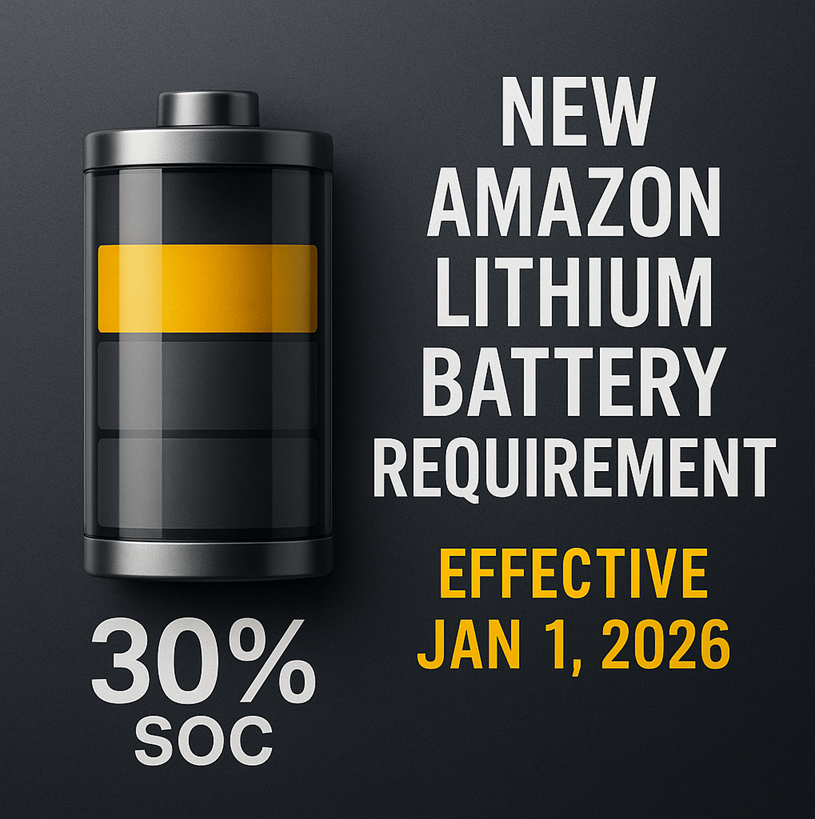Amazon's New Lithium Battery Rules for 2026: What Sellers Need To Do Before It's Too Late
Amazon's New Lithium Battery Rules for 2026: What Sellers Need To Do Before It's Too Late

Most Amazon sellers still don’t realize what’s coming.
Buried quietly inside Seller Central is a policy update that will impact almost every rechargeable product on the marketplace in 2026. It’s the kind of update that doesn’t go viral, but absolutely destroys unprepared listings the moment enforcement begins.
Amazon posted it here:
Policy update:
https://sellercentral.amazon.com/seller-news/articles/QVRWUERLSUtYMERFUiNHWEw1RFdCNExHQVg3VjNO
If you sell anything with a lithium-ion battery – or anything that ships with a rechargeable battery inside the box – the clock is ticking.
Deadline: December 31, 2025
Enforcement: January 1, 2026
This article breaks down the update in human terms, explains what’s actually happening behind the scenes, and shows you exactly what to do now so you don’t get hit with FBA blocks, hazmat holds, or inventory destruction in early 2026.
Let’s get straight into it.
Why Amazon Is Suddenly Cracking Down on Lithium Batteries
This is not an Amazon decision.
This is aviation-level pressure.
Lithium batteries are one of the most strictly regulated items in global transportation for a simple reason: when damaged or improperly charged, they can overheat, ignite, or explode. Airlines have been fined millions. Fulfillment centers have burned. Shipping carriers are terrified of undocumented lithium batteries.
Authorities like ICAO and IATA have new standards, and Amazon is aligning with them.
So instead of Amazon taking the risk, Amazon is forcing sellers to certify:
the battery
the packaging
the state of charge
the documentation
the WH limits
regional safety compliance
If anything is missing or inconsistent, Amazon blocks the ASIN – instantly and without negotiation.
The Most Important Change: State of Charge (SOC) Is Now Mandatory
This is the heart of the update.
Amazon now requires sellers to certify that any lithium-ion battery shipped with equipment is at 30 percent state of charge or less.
Not around 30.
Not “factory charged.”
Not “supplier said it’s fine.”
Thirty percent or less. Exactly.
Here’s the part many sellers miss:
Your supplier will not follow this rule unless you ask them to.
Most products ship with 60 percent SOC.
Most factories don’t track SOC at all.
Most don’t have written SOC declarations.
But Amazon is now asking for it upfront in the battery compliance questionnaire. If you don’t answer “Yes,” Amazon will immediately switch your ASIN to:
ground-only transportation
slower inbound
slower delivery
reduced Buy Box share
hazmat review
It doesn’t matter if the product is tiny, cheap, or harmless.
If it contains lithium-ion, this rule applies.
This requirement is documented here:
Dangerous goods (hazmat) required information and documentation:
https://sellercentral.amazon.com/help/hub/reference/G201371860
Amazon Is Not Asking for “More Info” - They’re Asking for EVERYTHING
The battery questionnaire you see in Seller Central now goes far deeper than anything Amazon required before. The goal isn’t to classify your product – it’s to verify it is legally allowed on an airplane.
The new fields cover:
battery weight
battery chemistry
number of cells
WH rating
voltage
amp-hours
IEC code
replaceable or sealed
OEM or non-OEM
installation device type
multiple battery-powered components
packaging type (in equipment, with equipment, or standalone)
SOC < 30 percent
lithium content
battery type mapping across categories
And here’s the painful part:
All of this must match your SDS, your UN 38.3, and your battery label.
If Amazon detects a mismatch, your product is flagged as hazardous goods:
FBA blocked
Inbound rejected
Inventory placed under review
14-business-day deadline to provide documents
Possibility of automatic disposal
This is exactly where most sellers will fall.
UN 38.3: The Requirement Most Sellers Don’t Realize They’re Missing
UN 38.3 testing isn’t new.
But Amazon enforcing it at ASIN creation absolutely is.
Amazon now requires:
A valid UN 38.3 test summary for every lithium-ion battery model used in your product.
This is where sellers get blindsided:
Some factories never performed the test.
Some have outdated summaries.
Some summaries are incomplete.
Many list the wrong product model.
Many use generic, invalid “template” versions.
Some have missing signatures, missing lab identities, or missing sections.
Amazon will reject all of those.
This requirement lives here:
Requirements for lithium batteries:
https://sellercentral.amazon.com/help/hub/reference/G200383420
If the UN 38.3 document doesn’t perfectly align with the actual battery in your device, Amazon does not approve the ASIN.
No appeal. No exceptions.
Hazmat Review Is About To Become a Traffic Jam
Under normal conditions, Hazmat review takes 2 business days.
During major compliance updates?
We’ve seen reviews stretch to:
7 days
10 days
Sometimes 2 weeks
Now imagine thousands of sellers all updating lithium-battery data in December.
The backlog will be brutal.
If your ASIN gets stuck in hazmat review in January, it will not move quickly. And if your inbound gets paused, your Q1 inventory sits in limbo while competitors continue selling.
This is why waiting until December 30 is a guaranteed mistake.
The Cross-Market Trap Almost No One Sees
Amazon published regional watt-hour limits by country.
The differences are… dramatic.
For example:
The US allows certain lithium-ion cells up to 20 Wh
Europe rejects many above 20 Wh
Some marketplaces reject battery packs above 100 Wh
Others reject anything above 60 Wh
This means:
Your product may be legal in the US but illegal in EU marketplaces.
And Amazon will check for consistency across regions.
If your US listing says 45 Wh but your EU ASIN says 20 Wh, Amazon may:
block the EU listing
flag your catalog
request documentation
suspend FBA for that product line
This is the hidden consequence that 90 percent of sellers won’t understand until they see the red flag on their dashboard.
A Real Example of How Fast Things Go Wrong
We once reviewed an SDS from a supplier who swore everything was “completely compliant.”
Here’s what we found:
SDS age: 7 years old
Battery label: 3.7V 1200mAh
SDS: 1000mAh
UN 38.3 document: different battery model altogether
Listing: WH value missing
Hazmat team: classified it as “unknown” → blocked
This new update will amplify these issues tenfold.
Sellers who rely on “default” manufacturer documents will be the first to get blocked.
Who Should Be Paying Attention Right Now
If your product:
charges
includes a rechargeable battery
ships with a backup battery
is powered by an internal battery
includes a battery-powered accessory in the box
uses Li-ion, Li-polymer, Li-metal, LiFePO4, or any modern chemistry
…it falls under this rule.
Categories at highest risk:
dog training collars
beauty and skincare devices
massagers
earbuds and headphones
electric toothbrushes
bike lights
flashlights and headlamps
toys with built-in rechargeable components
handheld electronics
tools and battery packs
baby monitors
smart home devices
barcode scanners
rechargeable kitchen gadgets
If it plugs in or charges, it’s affected.
Your 2026 Action Plan (Do This Now, Not Later)
Here’s the straight answer:
If you take these steps now, you won’t need help later – and you won’t become one of our clients scrambling in January.
1. Ask your supplier for these four documents today
Updated SDS (issued within the last 5 years)
UN 38.3 test summary for the exact battery model
A written SOC declaration confirming they ship at 30 percent or less
A spec sheet listing WH, voltage, Ah, chemistry, and cell count
If they hesitate, push harder.
If they can’t provide them, consider changing suppliers.
2. Update the Amazon battery information fields
Every field must match your documents exactly.
If one number differs, Amazon will block the listing.
3. Upload the SDS or exemption sheet
Don’t wait for Amazon to ask.
Submitting early prevents sudden “14-day notices.”
4. Audit your catalog for regional WH conflicts
Check:
US
EU
UK
CA
MX
The WH limits are different everywhere.
5. Confirm WH, voltage, and Ah on the physical product
Amazon cross-checks listings against warehouse inspections.
Mismatch = instant hazmat block.
6. Add SOC verification to your packaging and inspection process
Even if you never publish it to Amazon, keep the documentation internally.
Final Thought: Most Sellers Will Wait. Don’t Be One of Them.
January 1 won’t feel dramatic – until Amazon turns on enforcement.
Then you’re going to see:
inbound shipments rejected
ASINs blocked
performance notifications piling up
inventory placed on hold
14-day deadlines
forced disposal
Buy Box collapses
delivery windows extending
The sellers who prepare in November–December will be the ones still delivering in January. The ones who don’t will be chasing documents from suppliers who are suddenly “on holiday.”
If you take action now, you won’t need our help later.
And frankly, that’s the best possible outcome.
